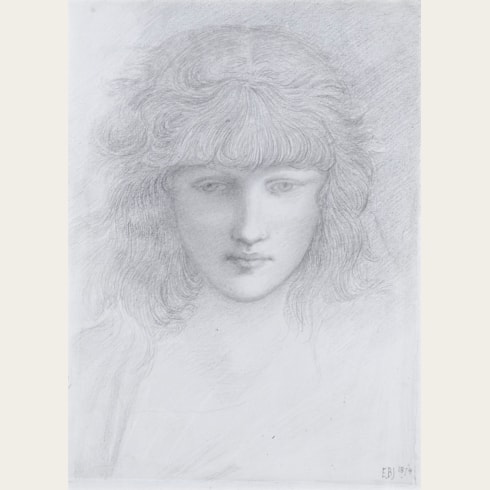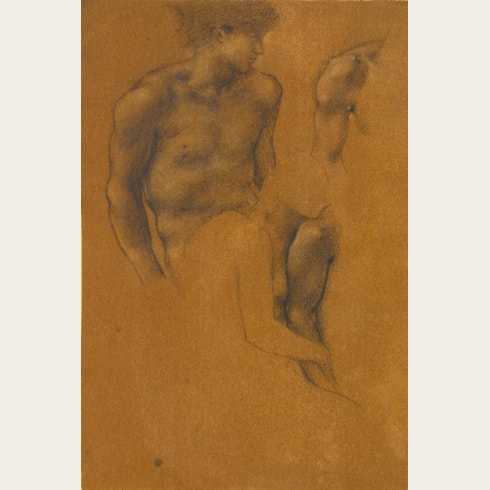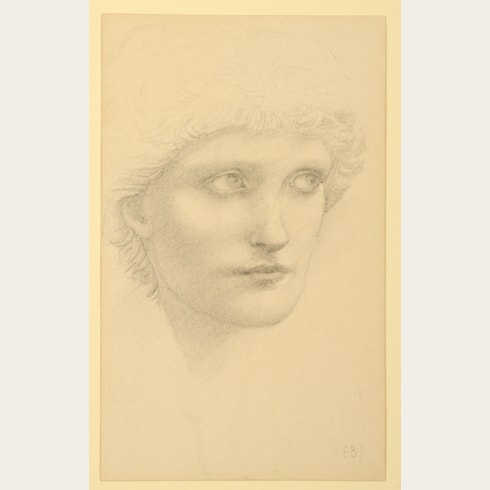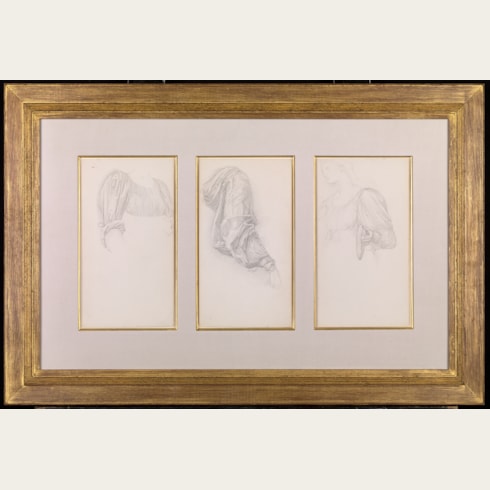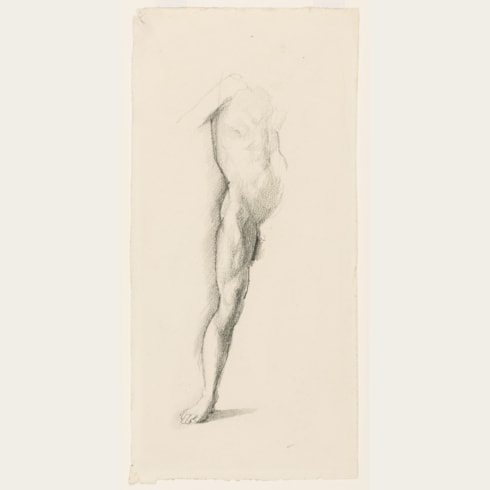Edward Coley BURNE-JONES
(Birmingham 1833 - London 1898)
The Head of a Woman in Profile: Study for The Last Sleep of Arthur in Avalon
241 x 149 mm. (9 1/2 x 5 7/8 in.)
As Burne-Jones’s wife later recalled of The Last Sleep of Arthur in Avalon, ‘the idea of it lay deep in Edward’s mind and the scope of it grew until it ceased to suit its original purpose, and Mr. George Howard resigned his claim upon it. Then it became Edward’s own cherished design, and he regarded it as a task of love to which he put no limit of time or labour.’ Following the artist’s death the huge canvas was shown in the Burne-Jones Memorial Exhibition of 1898, and it was then acquired from the painter’s estate by Charles Sydney Goldman, a collector of Pre-Raphaelite art. It was not again seen in public until it was shown at the Royal Academy in 1916, during the height of the First World War. Offered on long-term loan by Goldman to the Tate Gallery in 1929, it was shown in an exhibition there four years later, on the centenary of the artist’s birth, after which it was again nearly forgotten, rolled up and stored in a large box. The massive painting was sold by the heirs of Charles Goldman at auction in London in 1963, when it was bought, for £1,680, by the Puerto Rican industrialist and collector Luis Antonio Ferré. The Last Sleep of Arthur in Avalon has since remained in Puerto Rico for almost sixty years, apart from being briefly exhibited in London in 2008.
Having worked on the project for so many years, Burne-Jones produced a huge number of preparatory drawings for the painting. The Last Sleep of Arthur in Avalon depicts the sleeping figure of King Arthur surrounded by musicians and attendants. The present sheet is a study for the head of the attendant playing a stringed instrument, seated at Arthur’s feet. The model for this figure was the Anglo-Greek artist Maria Spartari Stillman (1844-1927), a cousin of Burne-Jones’s model and sometime lover Maria Zambaco. A talented painter in her own right, Stillman was never a professional model, however, and only posed occasionally, as a favour, for fellow artists such as Dante Gabriel Rossetti, Ford Madox Brown, John Roddam Spencer Stanhope and the photographer Julia Margaret Cameron, as well as Burne-Jones.
Spartari Stillman also posed for one other figure in The Last Sleep of Arthur in Avalon, namely the standing Watcher holding a long horn, fourth from the left. A closely comparable drawing for the head of this figure, probably drawn at the same time as the present sheet and sharing the same provenance until 1963, is now in an English private collection. Another similar drawing of her, preparatory for Danaë and the Tower of Brass, is in the Glasgow Art Gallery.
The first owner of the present sheet, Major Charles Sydney Goldman (1868-1958), was a businessman, MP, journalist and art patron who assembled a number of important paintings, drawings and tapestries by Burne-Jones. Goldman acquired the monumental canvas of The Last Sleep of Arthur in Avalon, as well as several drawings related to it, including the present sheet, from Burne-Jones’s heirs shortly after the artist’s death.
The leading member of the second generation of Pre-Raphaelite painters, Edward Burne-Jones studied at Exeter College, Oxford, where he met William Morris. The two were to remain lifelong friends and colleagues, with Burne-Jones executing designs for stained glass windows, ceramic tiles and tapestries for Morris and Company for more than thirty-five years. Another close friend was Dante Gabriel Rossetti, who gave Burne-Jones some of the little artistic training he received, otherwise being largely self-taught. From early in his career Burne-Jones enjoyed a measure of success, particularly as a designer of stained glass panels. In 1859 he made the first of four trips to Italy, a country whose art he found of considerable inspiration throughout his life. In 1877 he showed a total of eight paintings at the inaugural exhibition at the Grosvenor Gallery, established as a more radical alternative to the Royal Academy. The success of these pictures, and his continued participation in the yearly Grosvenor exhibitions, established Burne-Jones's reputation as a leader of the Aesthetic movement. His fame also spread to Europe, and in particular Paris, where his painting of King Cophetua and the Beggar Maid was greatly admired at the Exposition Universelle of 1889.
A passionate and prolific draughtsman, Burne-Jones produced countless preparatory studies and cartoons for his paintings, as well as drawings intended as independent works of art in their own right, in black and red chalk, pencil, pen and watercolour. His drawings were, indeed, of arguably greater significance to him than his finished paintings; as John Christian has noted, Burne-Jones ‘was always a draughtsman first and a painter second.’ Similarly, the artist’s friend Graham Robertson wrote that ‘He was pre-eminently a draughtsman, and one of the greatest in the whole history of Art…as a master of line he was always unequalled; to draw was his natural mode of expression – line flowed from him almost without volition.’ Although he occasionally gave drawings away as presents, and also sometimes exhibited them in public, Burne-Jones seems to have kept most of his drawings in his studio until his death, after which they were dispersed.
Provenance
By descent to his sons, Commander Victor Robert Penryn Monck and John Goldman Monck, London
Their sale, London, Christie’s, 26 April 1963, part of lot 87 (‘Studies of Heads – in various media – (four on three mounts)’, sold for £47,5s.)
H. Shickman Gallery, New York, in 1969
Robert and Helen Mandelbaum, New York
Thence by descent to a private collection, New York.
Exhibition






